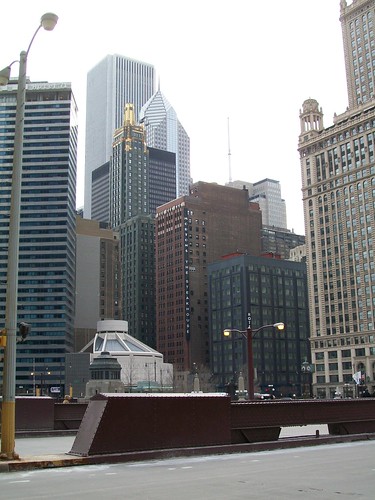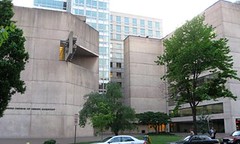The slippery slope of economic hardship arguments to obviate historic preservation protections

This photo shows (somewhat) the downtown Christian Scientist Church, the Seventeenth Church of Christ, Scientist, at 55 East Wacker Drive in Chicago. There is a much better image of the church in this Wikipedia entry. The building was designed by Harry Weese, who designed DC's underground subway stations. The church remains extant, under no threat of demolition.
For different reasons than the Mayor's Agent found, I likely would have made a decision in favor of demolition of the 3rd Church of Christ, Scientist, that for reasons of "special merit," an exception from DC's historic preservation laws is justified. See "Demolition OK’d for historic church after maintenance found too costly" from the Examiner and "D.C. OKs demolition of Christian Science Church" from the Washington Business Journal, which discuss the case.

Third Church of Christ, Scientist, DC. DC Preservation League photo.
The Church argued that they don't generate enough income from operations to maintain the church building, that the brutal modernist architecture of the building is too expensive to maintain, and that forcing them to keep the building (designed by the prominent architect I.M. Pei even if this particular building isn't necessarily one of the best from his oeuvre) is both an economic hardship and an impingement of their freedom of expression as it relates to religion.
There is a saying in law (note that I am not a lawyer) that good cases make bad law. This case is a good example.
From an urban design standpoint, the building doesn't work on at least three levels, internally in terms of how it functions, the cost of maintenance, and it how it fails to connect to the city beyond the confines of the lot.
"Special merit" cases are supposed to be decided on the basis that the benefit of change exceeds the benefits that are reaped from keeping the building the same.
And generally, in past cases, DC Courts have decided that economic hardship is not considered a strong enough reason to obviate local historic preservation laws in DC despite Marc Fisher's focus on individuals rather than processes, structures, and systems, as exemplified in his piece in the Post, "D.C. Lets Church Tear Down Brutalist Atrocity." From the article:
In the eternal battle between the people who live in the city and an arrogant elite who think they know better, score one for the people...
Comment: it's the pot calling the kettle black for the Post to call historic preservationists "elitist." If you care about the city and its ability to maintain its competitive advantages vis-a-vis "Anyplace USA" then you have to be on guard always, in terms of maintaining the qualities of historic architecture, urban design, and identity, authenticity and historicity.
The thing is, judging the matter on those qualities, I think letting the building be demolished is a good decision. But the logic within the case is not based on those factors, which I find troubling.
Economic hardship arguments are relative, not absolute, arguments. Frankly, the Christian Science Church doesn't have many members, and it seems like if it were better managed they could generate at least $265,000 in revenues, and therefore be able to pay for maintaining their expensive to maintain building.
The holding in Kalorama Heights Ltd. Partnership v. District of Colum. Dep't of Consumer and Reg. Aff. 655 A.2d 865, 873 (D.C. 1995) provides a basis for argument about the primacy of building regulations in this instance. This case found that plaintiff declaration of economic hardship, in and of itself, was not strong enough to obviate building regulations in favor of plaintiff exhortation of property rights, especially given that the plaintiff was aware of the existence of said building regulations before they purchased the property. (This is a little different, but not entirely, for this case as the possibility of application of these laws vis-a-vis the Church property has always existed.)
As far as the expression of religion arguments, it's very important in a defense against RLUIPA to distinguish between the every day activities around owning a property versus how first amendment rights are exercised while using that property, and that it is eminently possible to sever the building regulation aspects of property ownership from the first amendment issues involved in using a property. There is very little that is special about the use of a property with regard to first amendment expression. Using a building in and of itself isn't related to the exercise of first amendment freedoms, unless somehow, building regulations are written specifically to limit expression of first amendment rights.
Sadly, the Federal District Court did not agree, but it tends to be a somewhat "conservative" circuit, see "Tear down Third Church or I will, judge tells DC" from Greater Greater Washington.
Labels: historic preservation



0 Comments:
Post a Comment
<< Home